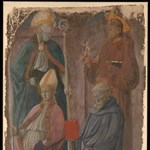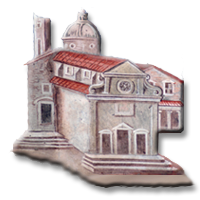This badly damaged and fragmentary work—the paint film has been transferred to paper and mounted on canvas—is the remains of the right side of an imposing altarpiece that may have shown in the center a Madonna and Child and on the left four more saints. The two foreground saints, often identified as Louis of Toulouse and Benedict, are shown kneeling while those behind—a bishop (Augustine?) and Francis of Assisi—stand within an architectural enclosure such as Lippi often employed (see, for example, 49.7.9). Because of the poor state of preservation there has been little consensus concerning the attribution and dating of the picture, which for many years was known primarily from a photograph taken prior to the second time its flaking paint surface was transferred to a new support in 1949. The picture can now be studied better than at any time in the past and from this it is clear that the picture is largely by Filippo Lippi and, as Ruda (1993) argues, dates from the "early or middle1440s". (Ruda examined the picture prior to its adhesion to a new support, at a time when the reverse side of the paint surface could also be studied.) The work presenting the closest stylistic analogies is the Annunciation (Alte Pinakothek, Munich) that was painted for the high altar of the Benedictine convent of Le Murate (Florence). Lippi painted two altarpieces for that church, one dedicated to the Annunciation and the other to Saint Bernard, and it is not completely out of the question that the MMA painting is a surviving fragment from the second altarpiece (this is the suggestion of Keith Christiansen). Both works were financed by Giovanni d’Amerigo Benci and, according to a chronicle of 1597, were completed in 1443, though that date cannot be taken as definitive. Unfortunately, we know almost nothing about the appearance of the Saint Bernard altarpiece, except that, according again to the 1597 chronicle, it had been badly damaged in a flood fifty years earlier ("andò in pezzi": see Megan Holmes, "Giovanni Benci’s Patronage of the Nunnery, Le Murate." Art, Memory, and Family in Renaissance Florence. Ed. G. Ciapelli and P. Rubin. Cambridge, 2000, pp. 114–15; and, for a transcription of the chronicle, Saundra Lynn Weddle, "Enclosing Le Murate", Ph.D. diss., Cornell University, 1997, p. 379). Francesco Albertini, in his Memoriale di molte statue et picture sono nella inclyta Cipta di Florentia (1510, p. 5) says only that for the convent Lippi "made two very beautiful altarpieces" (felce due bellissime tauole). To this Vasari adds that the altarpiece in the chapel of Saint Bernard included stories of Saints Benedict and Bernard, most likely referring to the predella.



